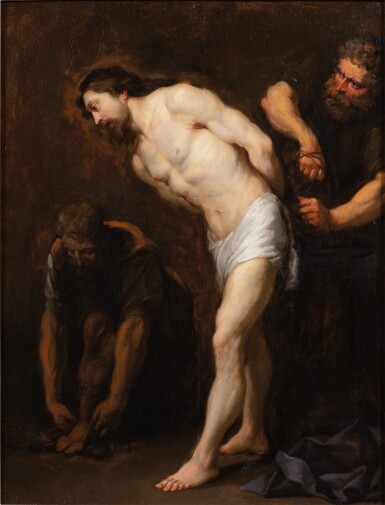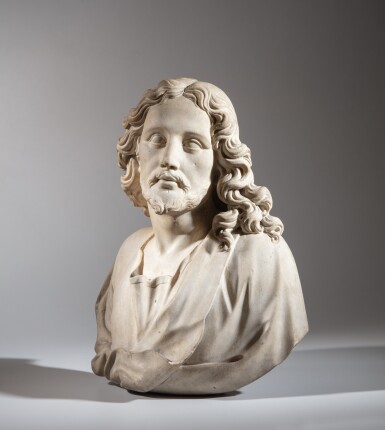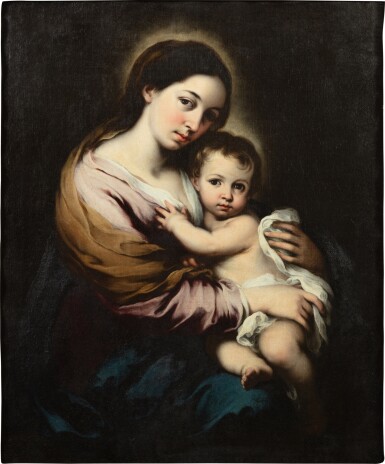Alfred de DreuxParis 1810 - 1860Black Knight
Oil on canvasSigned lower left Alfred. de Dreux91,9 x 73,8 cm ; 36 ⅛ by 29 in.____________________________________________
Alfred de DreuxParis 1810 - 1860Black Knight
Huile sur toileSigné en bas à gauche Alfred. de Dreux91,9 x 73,8 cm ; 36 ⅛ by 29 in.Condition reportFor further information on the condition of this lot please contact clemence.enriquez@sothebys.com Please note: Condition XVI of the Conditions of Business for Buyers (Online Only) is not applicable to this lot. (Veuillez noter que l'Article XVI des Conditions Générales de Vente applicables aux Vendeurs (Ventes Effectuées Exclusivement en Ligne) n'est pas applicable pour ce lot.)
The lot is sold in the condition it is in at the time of sale. The condition report is provided to assist you with assessing the condition of the lot and is for guidance only. Any reference to condition in the condition report for the lot does not amount to a full description of condition. The images of the lot form part of the condition report for the lot. Certain images of the lot provided online may not accurately reflect the actual condition of the lot. In particular, the online images may represent colors and shades which are different to the lot's actual color and shades. The condition report for the lot may make reference to particular imperfections of the lot but you should note that the lot may have other faults not expressly referred to in the condition report for the lot or shown in the online images of the lot. The condition report may not refer to all faults, restoration, alteration or adaptation. The condition report is a statement of opinion only. For that reason, the condition report is not an alternative to taking your own professional advice regarding the condition of the lot. NOTWITHSTANDING THIS ONLINE CONDITION REPORT OR ANY DISCUSSIONS CONCERNING A LOT, ALL LOTS ARE OFFERED AND SOLD "AS IS" IN ACCORDANCE WITH THE CONDITIONS OF SALE/BUSINESS APPLICABLE TO THE RESPECTIVE SALE.ProvenanceTalleri Collection;Anonymous sale, Savot, Orléans, 21 May 1992, lot 1 (titled Portrait de la jument « Black Lady »);Anonymous sale, Sotheby’s Monaco, 5 December 1992, lot 72 (titled Portrait de la jument « Black Lady »);Private collection, France;With Galerie Ary Jan, Paris;Private collection, France. ____________________________________________
Collection de Talleri ;Vente anonyme, Savot, Orléans, 21 mai 1992, lot 1 (sous le titre Portrait de la jument « Black Lady ») ;Vente anonyme, Sotheby’s Monaco, 5 décembre 1992, lot 72 (sous le titre Portrait de la jument « Black Lady ») ;Collection particulière, France ;Galerie Ary Jan, Paris ;Collection particulière, France. LiteratureM.-C. Renauld, L'univers d'Alfred de Dreux (1810-1860) suivi du catalogue raisonné, Paris, 2008, p. 69, n° 300 (repr.).Catalogue noteWe are grateful to Brame & Lorenceau for having confirmed the authenticity of the work. It will be included in their forthcoming catalogue of the works by Alfred de Dreux.
Alfred de Dreux’s name is indissolubly linked to equine painting, a genre that made his reputation and that he revered. From a family of successful French painters, in his youth the future artist was able to admire the great Roman examples, such as the Marcus Aurelius on the Capitoline Hill, while his father was a pensionnaire at the Villa Medici. However, it was in the studio of his uncle, Pierre-Joseph Dedreux-Dorcy, that he developed a taste for painting horses. Here, he got to know Théodore Géricault a close family friend. It was this artist who inspired his particular interest in the horse, which he associated intrinsically with the idea of beauty. When Géricault died, Alfred de Dreux continued his apprenticeship in Léon Cogniet’s studio. Recognized as a court painter from 1833, he also worked in Eugène Isabey’s studio. His successes at the Salon now began to multiply, as did his commissions, especially from the State. Alfred de Dreux was much admired and sought after in the society circles that were familiar to him and into which he was completely integrated. With a truly passionate interest in his chosen subject matter, the artist bought superb horses himself and regularly attended the races at Longchamp and Maisons-Laffitte. His talent and his tireless capacity for work allowed him to live the life of a dandy. His output, created at the heart of an anglophile, elegant and refined Paris, reflects his fascination with the equine species.
Black Knight, a beautiful Arabian thoroughbred, is one of the most conclusive examples of Alfred de Dreux’s unmatched expertise and technique in the depiction of the most beautiful equine specimens. The horse’s satiny coat is skilfully rendered, revealing the artist’s elegant touch and ability to capture the contrasts between the gleaming light and shadows. His free and spirited manner can also be seen in the depiction of the movement in the sky and nature surrounding the horse: Jacques Foucart considers that it may even be in this respect that Alfred de Dreux’s genius is most compelling. Much more than a simple equine painter, Alfred de Dreux is a distinguished landscape painter, as can be appreciated in this oil on canvas. ____________________________________________
Nous remercions Brame & Lorenceau d'avoir confirmé l'authenticité de cette œuvre. Elle sera incluse dans le catalogue critique de l'artiste actuellement en préparation.
Le nom d’Alfred de Dreux ne peut être dissocié de la peinture équestre, genre qui a fait sa réputation et qu’il a magnifié. Issu d’une famille fortunée d’artistes français, le futur peintre, dont le père Pierre-Anne de Dreux est pensionnaire à la Villa Médicis, peut observer dans sa jeunesse les grands exemples romains, comme le Marc-Aurèle du Capitole. C’est pourtant dans l’atelier de son oncle, Pierre-Joseph Dedreux-Dorcy, qu’il prend goût à dessiner les chevaux. Il y fait la connaissance de Théodore Géricault ami intime de la famille. De l’artiste, il hérite une attention particulière à l’animal, qu’il associe à l’idée même de la beauté. A la mort de Géricault, Alfred de Dreux continue son apprentissage dans l’atelier de Léon Cogniet Reconnu comme peintre de cour dès 1833, il travaille également dans l’atelier d’Eugène Isabey. Dès lors, les succès au Salon et les commandes, notamment de l’Etat, se multiplient. Alfred de Dreux est adulé et recherché par la bonne société qu’il connaît et à laquelle il est parfaitement intégré. En véritable passionné de son sujet de prédilection, le peintre achète de superbes chevaux et fréquente assidûment les courses de Longchamp et de Maisons-Laffitte. Son talent et son travail acharné lui permettent de mener ce train de vie de dandy. Son œuvre est le miroir de son engouement pour cet animal, au cœur d’un Paris anglophile, élégant et raffiné.
Black Knight, un magnifique pur-sang arabe, est l’un des exemples les plus probants de l’expertise et de la technique incontestables d’Alfred de Dreux dans la représentation des plus beaux spécimens de chevaux. La robe satinée de l’animal est rendue avec justesse, et révèle une touche élégante et capable de saisir les chatoiements de la lumière et des ombres. La manière libre et enlevée de l’artiste se perçoit également dans la description des mouvements du ciel et de la nature qui enveloppent le cheval. C’est même là, selon Jacques Foucart, que le génie d’Alfred de Dreux est le plus éloquent. Bien plus qu’un simple peintre de chevaux, Alfred de Dreux est un éminent paysagiste, ce que cette huile sur toile nous permet d’apprécier.
Alfred de DreuxParis 1810 - 1860Black Knight
Oil on canvasSigned lower left Alfred. de Dreux91,9 x 73,8 cm ; 36 ⅛ by 29 in.____________________________________________
Alfred de DreuxParis 1810 - 1860Black Knight
Huile sur toileSigné en bas à gauche Alfred. de Dreux91,9 x 73,8 cm ; 36 ⅛ by 29 in.Condition reportFor further information on the condition of this lot please contact clemence.enriquez@sothebys.com Please note: Condition XVI of the Conditions of Business for Buyers (Online Only) is not applicable to this lot. (Veuillez noter que l'Article XVI des Conditions Générales de Vente applicables aux Vendeurs (Ventes Effectuées Exclusivement en Ligne) n'est pas applicable pour ce lot.)
The lot is sold in the condition it is in at the time of sale. The condition report is provided to assist you with assessing the condition of the lot and is for guidance only. Any reference to condition in the condition report for the lot does not amount to a full description of condition. The images of the lot form part of the condition report for the lot. Certain images of the lot provided online may not accurately reflect the actual condition of the lot. In particular, the online images may represent colors and shades which are different to the lot's actual color and shades. The condition report for the lot may make reference to particular imperfections of the lot but you should note that the lot may have other faults not expressly referred to in the condition report for the lot or shown in the online images of the lot. The condition report may not refer to all faults, restoration, alteration or adaptation. The condition report is a statement of opinion only. For that reason, the condition report is not an alternative to taking your own professional advice regarding the condition of the lot. NOTWITHSTANDING THIS ONLINE CONDITION REPORT OR ANY DISCUSSIONS CONCERNING A LOT, ALL LOTS ARE OFFERED AND SOLD "AS IS" IN ACCORDANCE WITH THE CONDITIONS OF SALE/BUSINESS APPLICABLE TO THE RESPECTIVE SALE.ProvenanceTalleri Collection;Anonymous sale, Savot, Orléans, 21 May 1992, lot 1 (titled Portrait de la jument « Black Lady »);Anonymous sale, Sotheby’s Monaco, 5 December 1992, lot 72 (titled Portrait de la jument « Black Lady »);Private collection, France;With Galerie Ary Jan, Paris;Private collection, France. ____________________________________________
Collection de Talleri ;Vente anonyme, Savot, Orléans, 21 mai 1992, lot 1 (sous le titre Portrait de la jument « Black Lady ») ;Vente anonyme, Sotheby’s Monaco, 5 décembre 1992, lot 72 (sous le titre Portrait de la jument « Black Lady ») ;Collection particulière, France ;Galerie Ary Jan, Paris ;Collection particulière, France. LiteratureM.-C. Renauld, L'univers d'Alfred de Dreux (1810-1860) suivi du catalogue raisonné, Paris, 2008, p. 69, n° 300 (repr.).Catalogue noteWe are grateful to Brame & Lorenceau for having confirmed the authenticity of the work. It will be included in their forthcoming catalogue of the works by Alfred de Dreux.
Alfred de Dreux’s name is indissolubly linked to equine painting, a genre that made his reputation and that he revered. From a family of successful French painters, in his youth the future artist was able to admire the great Roman examples, such as the Marcus Aurelius on the Capitoline Hill, while his father was a pensionnaire at the Villa Medici. However, it was in the studio of his uncle, Pierre-Joseph Dedreux-Dorcy, that he developed a taste for painting horses. Here, he got to know Théodore Géricault a close family friend. It was this artist who inspired his particular interest in the horse, which he associated intrinsically with the idea of beauty. When Géricault died, Alfred de Dreux continued his apprenticeship in Léon Cogniet’s studio. Recognized as a court painter from 1833, he also worked in Eugène Isabey’s studio. His successes at the Salon now began to multiply, as did his commissions, especially from the State. Alfred de Dreux was much admired and sought after in the society circles that were familiar to him and into which he was completely integrated. With a truly passionate interest in his chosen subject matter, the artist bought superb horses himself and regularly attended the races at Longchamp and Maisons-Laffitte. His talent and his tireless capacity for work allowed him to live the life of a dandy. His output, created at the heart of an anglophile, elegant and refined Paris, reflects his fascination with the equine species.
Black Knight, a beautiful Arabian thoroughbred, is one of the most conclusive examples of Alfred de Dreux’s unmatched expertise and technique in the depiction of the most beautiful equine specimens. The horse’s satiny coat is skilfully rendered, revealing the artist’s elegant touch and ability to capture the contrasts between the gleaming light and shadows. His free and spirited manner can also be seen in the depiction of the movement in the sky and nature surrounding the horse: Jacques Foucart considers that it may even be in this respect that Alfred de Dreux’s genius is most compelling. Much more than a simple equine painter, Alfred de Dreux is a distinguished landscape painter, as can be appreciated in this oil on canvas. ____________________________________________
Nous remercions Brame & Lorenceau d'avoir confirmé l'authenticité de cette œuvre. Elle sera incluse dans le catalogue critique de l'artiste actuellement en préparation.
Le nom d’Alfred de Dreux ne peut être dissocié de la peinture équestre, genre qui a fait sa réputation et qu’il a magnifié. Issu d’une famille fortunée d’artistes français, le futur peintre, dont le père Pierre-Anne de Dreux est pensionnaire à la Villa Médicis, peut observer dans sa jeunesse les grands exemples romains, comme le Marc-Aurèle du Capitole. C’est pourtant dans l’atelier de son oncle, Pierre-Joseph Dedreux-Dorcy, qu’il prend goût à dessiner les chevaux. Il y fait la connaissance de Théodore Géricault ami intime de la famille. De l’artiste, il hérite une attention particulière à l’animal, qu’il associe à l’idée même de la beauté. A la mort de Géricault, Alfred de Dreux continue son apprentissage dans l’atelier de Léon Cogniet Reconnu comme peintre de cour dès 1833, il travaille également dans l’atelier d’Eugène Isabey. Dès lors, les succès au Salon et les commandes, notamment de l’Etat, se multiplient. Alfred de Dreux est adulé et recherché par la bonne société qu’il connaît et à laquelle il est parfaitement intégré. En véritable passionné de son sujet de prédilection, le peintre achète de superbes chevaux et fréquente assidûment les courses de Longchamp et de Maisons-Laffitte. Son talent et son travail acharné lui permettent de mener ce train de vie de dandy. Son œuvre est le miroir de son engouement pour cet animal, au cœur d’un Paris anglophile, élégant et raffiné.
Black Knight, un magnifique pur-sang arabe, est l’un des exemples les plus probants de l’expertise et de la technique incontestables d’Alfred de Dreux dans la représentation des plus beaux spécimens de chevaux. La robe satinée de l’animal est rendue avec justesse, et révèle une touche élégante et capable de saisir les chatoiements de la lumière et des ombres. La manière libre et enlevée de l’artiste se perçoit également dans la description des mouvements du ciel et de la nature qui enveloppent le cheval. C’est même là, selon Jacques Foucart, que le génie d’Alfred de Dreux est le plus éloquent. Bien plus qu’un simple peintre de chevaux, Alfred de Dreux est un éminent paysagiste, ce que cette huile sur toile nous permet d’apprécier.















Try LotSearch and its premium features for 7 days - without any costs!
Be notified automatically about new items in upcoming auctions.
Create an alert